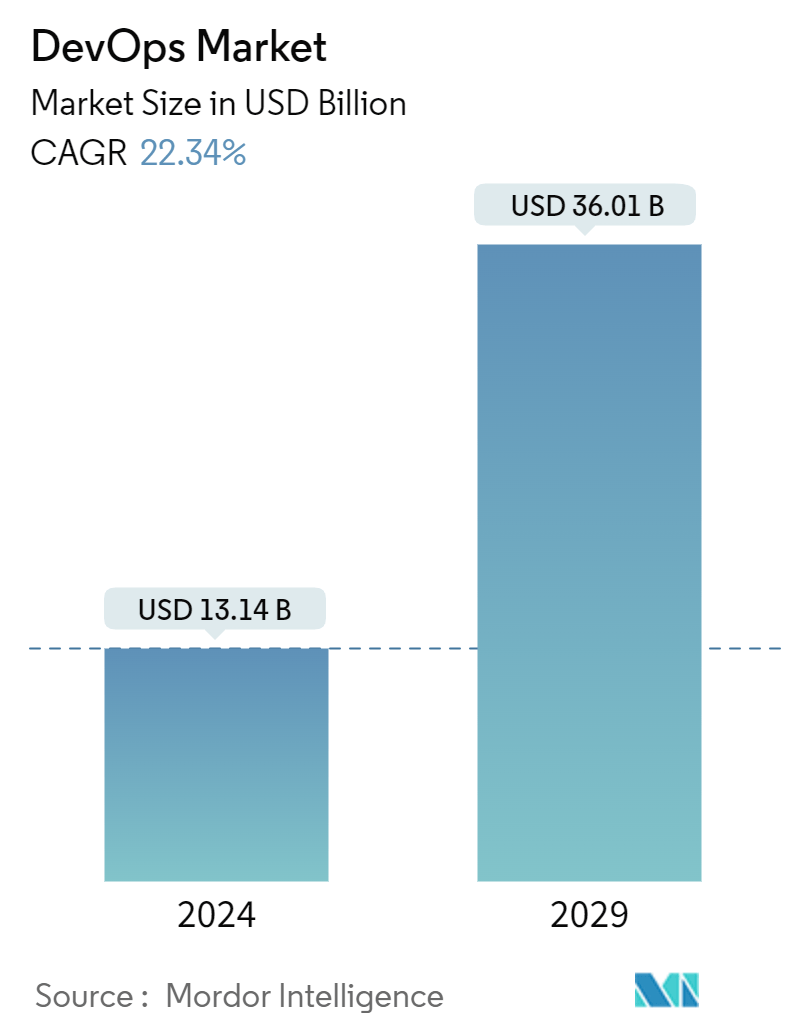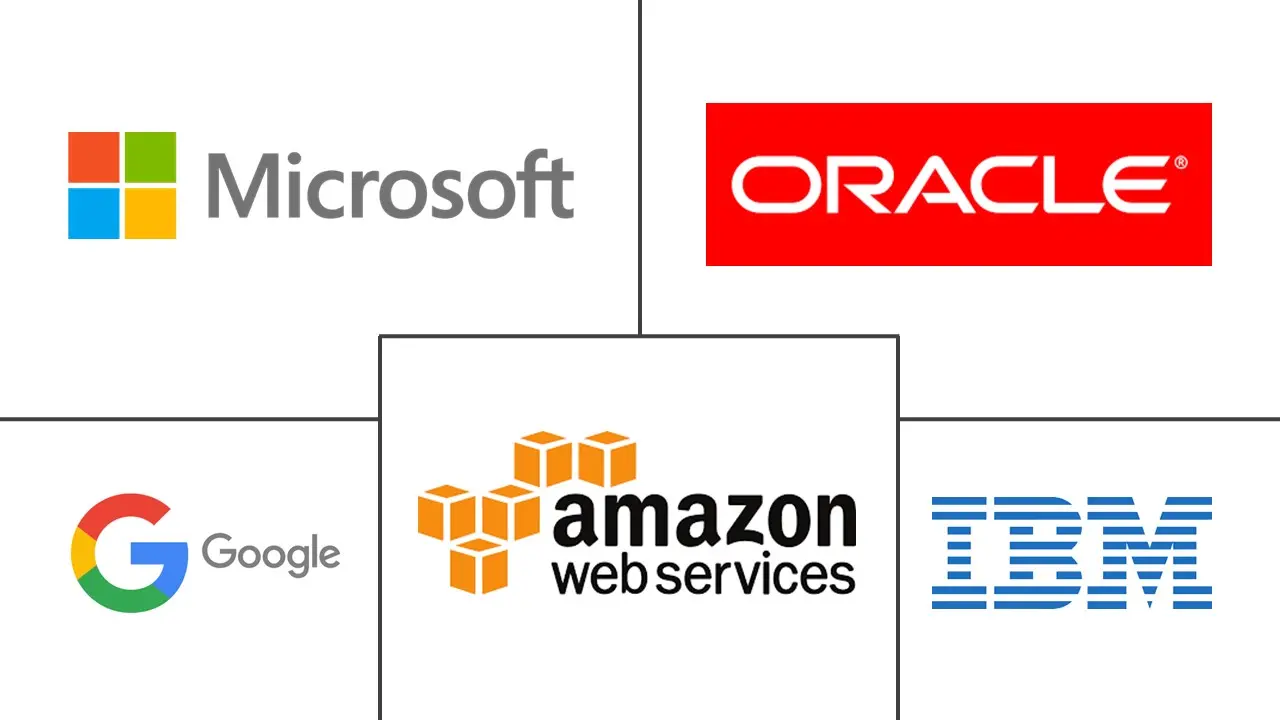| Study Period | 2019 - 2029 |
| Market Size (2024) | USD 13.14 Billion |
| Market Size (2029) | USD 36.01 Billion |
| CAGR (2024 - 2029) | 22.34 % |
| Fastest Growing Market | Asia Pacific |
| Largest Market | North America |
| Market Concentration | Medium |
Major Players*Disclaimer: Major Players sorted in no particular order |
DevOps Market Analysis
The DevOps Market size is estimated at USD 13.14 billion in 2024, and is expected to reach USD 36.01 billion by 2029, growing at a CAGR of 22.34% during the forecast period (2024-2029).
The increasing need for efficient and maintained operational processes and rising adoption of cloud computing coupled with PaaS lowered downtime in software development life cycles are pushing the growth of the DevOps Market. Different firms across the globe are focusing on decreasing the time and maintenance of the software development operation process. DevOps enables improved collaboration and synchronization among developers and reduces the maintenance of the constant development process.
- MLOps and AIOps are two of the renowned trending DevOps tools. Essential to optimize the DevOps processes to reap the benefits of high-quality and quick developments where MLOps and AIOps are important role players. AIOps enable automates IT processes and operations, whereas MLOps maintains the development system of machine learning. This is one of the widely used DevOps future trends, which has also been incorporated into a platform named DRYiCE IntelliOps, developed by HCL.
- As a solution that manages the full stack AIOps of the firms and its observability requirements, it specializes in converting the customers of HCL from reactive to proactive.
- The low-code approach enables agility, providing every firm with a competitive edge in the demanding and fast-paced software market. Low-code platforms enable businesses and enterprises to build applications without export coding knowledge. This allows non-technical professionals to also have a hand in creating software via a visual interface that entirely manages the app development process.
- It enables users to build their logic and workflow by dragging and dropping elements. This is one of the well-known DevOps trends that has enabled speed up the development and deployment process just by creating simplistic and user-friendly applications.
- Further, GitLab surveyed 5,001 technology managers and professionals and found a significant boost in DevOps practices over just the past 12 months. In 2022, a sizeable slice of respondents (47%) suggested DevOps or DevSecOps was their methodology of preference, a five percentage point increase over 2021.
- The survey shows that this rise in DevOps comes with an improved cadence in software delivery. 7 in 10 DevOps teams (70%) introduced code continuously, described as once a day or every few days, up 63 percent from last year. At least 60 percent of developers are developing code faster than before. A complete 35% said they are developing code twice as fast, while 15% release code between three and five times faster.
- One of the most common problems with DevOps is the challenge of holistically monitoring the entire process. DevOps consists of several moving parts, each with different metrics to judge their effectiveness. For example, a metric like the number of deployment frequency or code branches might deal with the CI/CD approach. Further, something like Defect Escape Rate is a component of the Continuous Testing pipeline. Often there needs to be clearer visibility over the entire process, leading to finger-pointing and production delays. Any manual processes made to envisage this lead to extensive labor and risks incorrect updates due to human error.
DevOps Industry Segmentation
DevOps is a set of tools and practices that automates and integrates the processes between software development and Information technology teams. It emphasizes team empowerment, cross-team communication and collaboration, and technology automation.
The DevOps market is segmented by solution (monitoring and performance management, lifecycle management, analytics, delivery and operation management, testing and development), by organization size (SME organization, large organization), by application (BFSI, retail, government, manufacturing, IT and telecommunication, healthcare), and by geography (North America, Europe, Asia Pacific, Middle East and Africa, Latin America).
The market sizes and forecasts are provided in terms of value (USD) for all the above segments.
DevOps Market Size Summary
The DevOps market is experiencing significant growth, driven by the increasing demand for efficient operational processes and the rising adoption of cloud computing. This growth is further supported by the integration of Platform as a Service (PaaS) solutions, which help reduce downtime in software development life cycles. Companies worldwide are focusing on enhancing collaboration among developers and minimizing the maintenance required in continuous development processes. The adoption of tools like MLOps and AIOps is becoming prevalent, as they play crucial roles in optimizing DevOps processes for high-quality and rapid development. Additionally, the low-code approach is gaining traction, enabling businesses to build applications without extensive coding knowledge, thus accelerating the development and deployment processes.
In the financial sector, DevOps is becoming a vital mechanism for driving digital transformation, with banks and financial services providers modernizing outdated systems to meet customer expectations and regulatory requirements. The implementation of DevSecOps is particularly important in this highly regulated industry, as it ensures the secure and efficient release of software. The market is moderately consolidated, with major players like Google, Microsoft, IBM, and Amazon Web Services investing in strategic partnerships and product developments to enhance their offerings. Recent developments include integrations and collaborations aimed at improving continuous integration and delivery capabilities, as well as leveraging artificial intelligence to boost software development efficiency. These advancements are helping organizations navigate the complexities of digital transformation while maintaining agility and security in their operations.
DevOps Market Size - Table of Contents
1. MARKET DYNAMICS
-
1.1 Market Drivers
- 1.1.1 Increasing Need for Reducing Software Development Process and Accelerating Delivery
- 1.1.2 Increase in Adoption of Software Automation
-
1.2 Market Restrains
- 1.2.1 Moving From Legacy Applications to Microservices
DevOps Market Research Faqs
How big is the DevOps Market?
The DevOps Market size is expected to reach USD 16.08 billion in 2025 and grow at a CAGR of 22.34% to reach USD 44.06 billion by 2030.
What is the current DevOps Market size?
In 2025, the DevOps Market size is expected to reach USD 16.08 billion.




